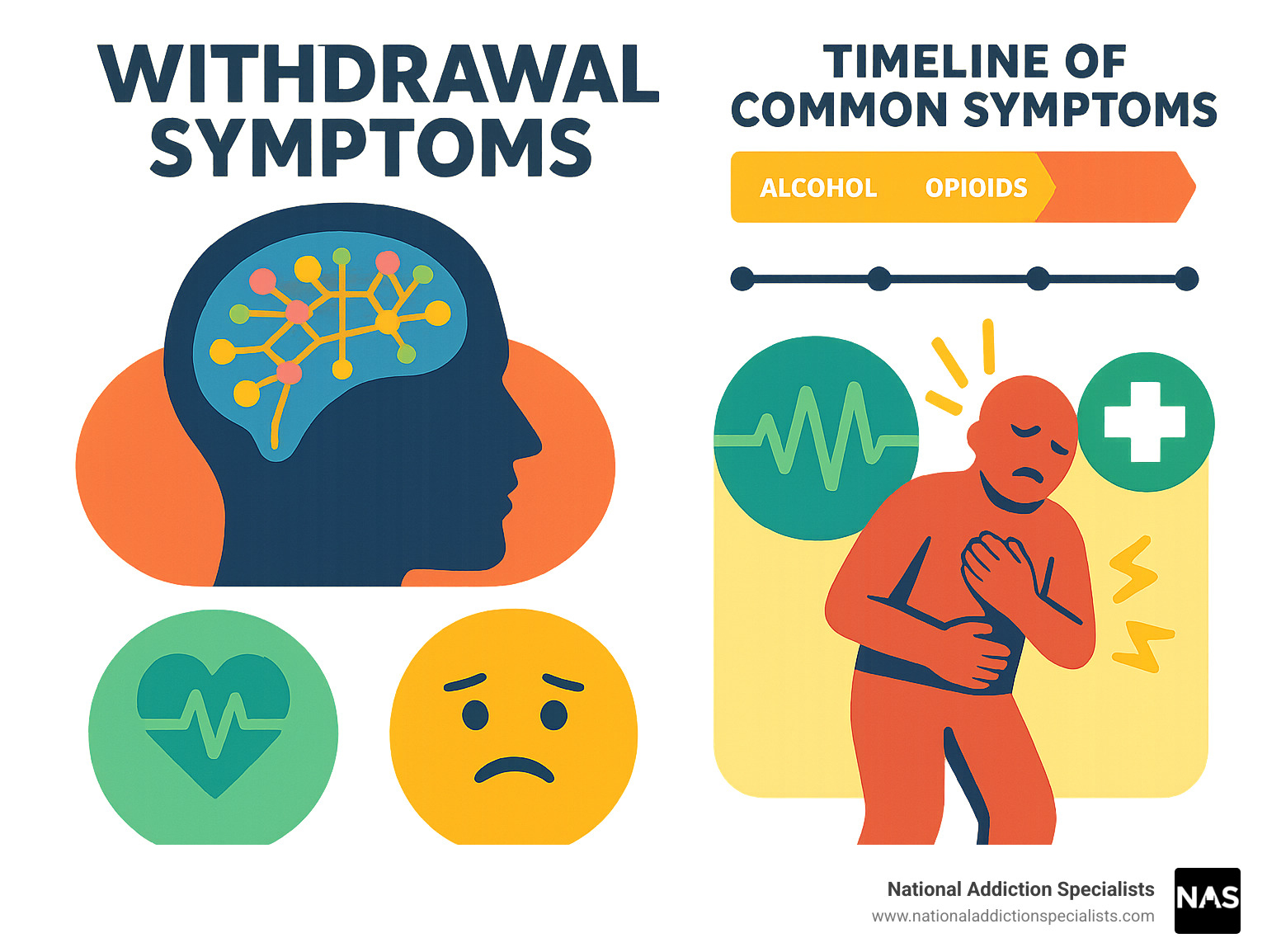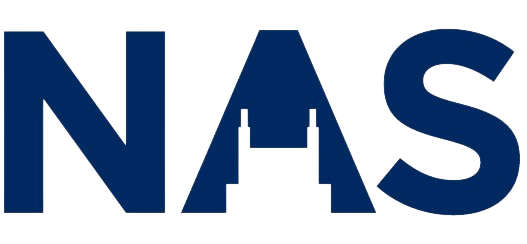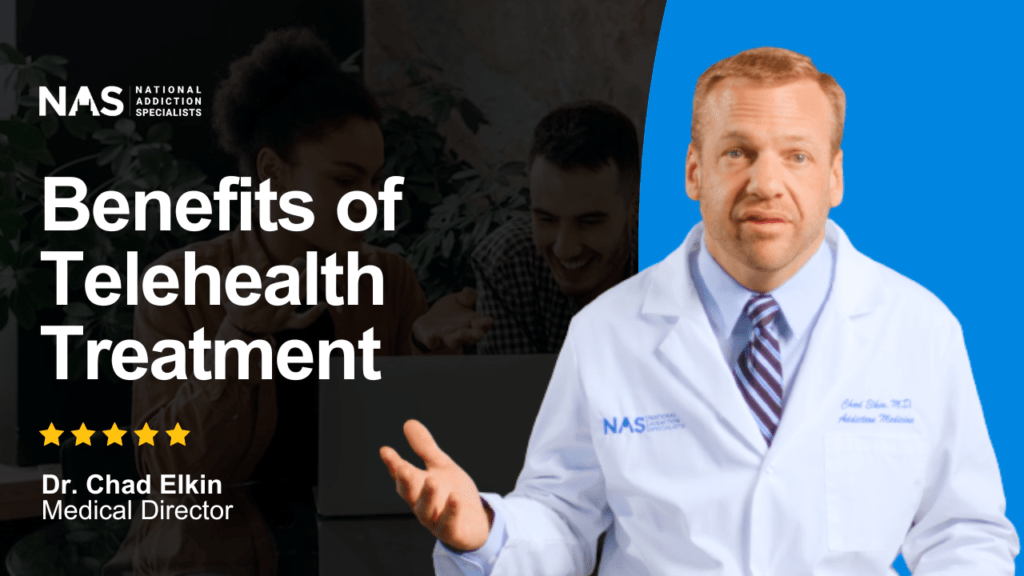What Are Withdrawal Symptoms and Why Do They Matter?
Withdrawal symptoms occur when you stop or reduce using a substance your body has become dependent on. These symptoms happen because your brain and body need time to readjust to functioning without the substance.
Quick Answer for Withdrawal Symptoms:
- Physical symptoms: Sweating, nausea, headaches, tremors, muscle aches
- Psychological symptoms: Anxiety, depression, irritability, cravings, difficulty concentrating
- Timeline: Symptoms typically start 6-24 hours after last use and can last days to weeks
- Severity varies by: Type of substance, duration of use, individual health factors
- Medical supervision: Often necessary for safety, especially with alcohol, opioids, and benzodiazepines
When someone uses alcohol, opioids, or other substances regularly, their brain adapts by changing its chemical balance. Think of it like your brain creating a new “normal” state. When you suddenly stop using the substance, your brain gets thrown into what experts call a “keyed up state” – essentially, it’s working overtime to restore balance.
This process affects your central nervous system and neurotransmitters, which control everything from your mood to your physical functions. That’s why withdrawal symptoms can range from mild discomfort to serious medical emergencies requiring immediate care.
The good news? Withdrawal is temporary, and with proper medical support, you can get through it safely. Understanding what to expect makes the process less scary and more manageable.
I’m Dr. Chad Elkin, a board-certified addiction medicine physician and founder of National Addiction Specialists. Over my years treating patients, I’ve guided thousands through withdrawal symptoms and seen how proper medical care transforms what feels impossible into achievable recovery. Let me walk you through everything you need to know about this crucial first step toward healing.

Withdrawal symptoms terms at a glance:
Introduction: What is Substance Withdrawal and Why Does It Happen?
Substance withdrawal symptoms are the physical and psychological reactions your body has when you stop or reduce a substance you’ve become dependent on. It’s your body’s response as it readjusts to functioning without the substance.
Why does this happen? Our bodies are amazing at adapting. When we regularly introduce a substance like alcohol, opioids, or benzodiazepines, our brain and central nervous system work hard to maintain a state of balance, or “homeostasis.” They adjust their natural production of neurotransmitters – the chemical messengers that control everything from mood to pain perception – to compensate for the presence of the substance. For example, alcohol depresses the central nervous system, so the brain might ramp up excitatory neurotransmitters to counteract this.
When you suddenly remove the substance, your brain is still operating in this adapted state. It’s like taking your foot off the brake but still having the engine revving. This leads to a “rebound effect,” where the body goes into overdrive, resulting in the uncomfortable and sometimes dangerous withdrawal symptoms we’re here to discuss. This complex interplay of brain adaptation and neurochemical changes is a core aspect of why dependence develops and why withdrawal occurs. You can learn more about the scientific basis of this in articles like Neurobiologic Advances from the Brain Disease Model of Addiction.
This physiological process is why withdrawal isn’t just “in your head”—it’s a real, measurable phenomenon requiring careful management. The specific symptoms and severity depend on the substance, duration of use, and individual health factors.
A Timeline of Common Withdrawal Symptoms
Think of withdrawal symptoms like a storm passing through – they don’t hit all at once, and they don’t last forever. Understanding the timeline can make this challenging journey feel more manageable and less scary.
Withdrawal symptoms typically follow a predictable pattern. They usually start within hours to days after your last use, reach their peak intensity, then gradually fade away. The exact timeline depends on several factors: what substance you’ve been using, how long you’ve used it, and your individual body chemistry.
You’ll experience both physical symptoms (like sweating, nausea, and tremors) and psychological symptoms (such as anxiety, depression, and cravings). Some people also face Post-Acute Withdrawal Syndrome (PAWS), where certain symptoms linger for weeks or months after the acute phase ends.
Let’s walk through what to expect with different substances, so you can prepare for your personal journey to recovery.
Alcohol Withdrawal Symptoms
Alcohol withdrawal can range from uncomfortable to life-threatening because it affects the central nervous system. The timeline is fast, with withdrawal symptoms often starting within 6 hours of the last drink. Early signs include anxiety, shaky hands, headaches, nausea, and sweating. Within 24-48 hours, some people may experience hallucinations. The most dangerous period is 48-72 hours after stopping, when seizures and the most severe form of withdrawal, Delirium Tremens (DTs), can occur. DTs involves severe confusion, high fever, and rapid heartbeat, affecting about 5% of those in withdrawal. This is why medical supervision is critical. Most symptoms peak within a few days and then improve. Learn more in our guides: How to Recognize the Signs of Alcohol Withdrawal and How Long Does Alcohol Withdrawal Last.
Opioid Withdrawal Symptoms
Opioid withdrawal symptoms are often compared to a severe flu. While rarely life-threatening, the intense discomfort makes it difficult to endure without support. Symptoms include muscle aches, sweating, diarrhea, nausea, vomiting, anxiety, and restlessness. The timeline varies by opioid type. For short-acting opioids (heroin, most painkillers), symptoms begin in 8-24 hours and last 4-10 days. For long-acting opioids (methadone), symptoms start in 12-48 hours and can last 10-20 days. A sudden, intense “precipitated withdrawal” can be triggered by naloxone (Narcan). Though severe, it’s temporary. For more details, see our resources: Opioid Withdrawal Symptoms and From Start to Finish Understanding the Suboxone Withdrawal Timeline.
Benzodiazepine and Stimulant Withdrawal
Benzodiazepine (Xanax, Valium) withdrawal is similar to alcohol withdrawal and can be dangerous, requiring medical supervision due to the risk of seizures. For short-acting benzodiazepines, symptoms start in 1-2 days and last 2-4+ weeks. For long-acting ones, symptoms begin in 2-7 days and last 2-8+ weeks. Key symptoms include severe anxiety, insomnia, and muscle spasms. Learn more at Benzodiazepine withdrawal information.
Stimulant withdrawal (cocaine, meth) is not typically life-threatening but is psychologically intense. Withdrawal symptoms begin within 24 hours, last 3-5 days, and often involve a “crash” with extreme fatigue, severe depression, and powerful cravings. The primary risk is severe depression, which can lead to suicidal thoughts, making professional support crucial.
Nicotine, Cannabis, and Caffeine Withdrawal
Withdrawal from nicotine, cannabis, and caffeine is real and can derail quit attempts, though it’s not typically medically dangerous.
- Nicotine withdrawal starts within hours, peaks in 2-3 days, and lasts 2-4 weeks. Expect irritability, headaches, concentration issues, and intense but brief (3-5 minute) cravings. The 7 Common Withdrawal Symptoms from Nicotine guide can help.
- Cannabis withdrawal is milder, lasting 1-2 weeks. Symptoms include irritability, anxiety, sleep problems, and decreased appetite.
- Caffeine withdrawal begins in 12-24 hours and lasts 2-9 days. It can cause headaches, fatigue, and irritability.
Experiencing any of these withdrawal symptoms doesn’t mean you’re weak or that recovery is impossible. It means your body is working to return to its natural balance. With the right support and medical care when needed, you can get through this temporary but challenging phase safely.
Navigating the Storm: How Withdrawal is Diagnosed and Managed
Facing withdrawal symptoms can feel like trying to sail through a hurricane without a compass. The good news? You don’t have to steer this storm alone. Medical professionals have developed systematic approaches to diagnose and manage withdrawal safely, turning what feels chaotic into a manageable journey toward recovery.

When you reach out for help, we start with a thorough clinical assessment and detailed patient history. Think of this as creating a roadmap for your recovery. We’ll ask about the type of substance you’ve been using, how much, how often, and for how long. This isn’t about judgment – it’s about understanding what your body is going through so we can help you heal.
We also conduct physical exams and use proven tools to measure your symptoms objectively. For alcohol withdrawal, we often use the CIWA-Ar scale (Clinical Institute Withdrawal Assessment for Alcohol, Revised). For opioid withdrawal, the COWS scale (Clinical Opioid Withdrawal Scale) helps us track your progress. These aren’t just fancy medical terms – they’re our way of making sure you get exactly the right care at exactly the right time.
Medical Detoxification and Supportive Care
Medical detoxification (detox) is the process of safely managing acute withdrawal symptoms under medical supervision. It’s a crucial first step in recovery. Detox can occur in an inpatient setting (24/7 monitoring, vital for severe alcohol/benzo withdrawal) or through outpatient care, like the convenient telemedicine services offered by National Addiction Specialists. Regardless of the setting, supportive care is key. This includes creating a safe environment, ensuring proper hydration and nutrition, providing necessary vitamin supplementation (like thiamine for alcohol withdrawal), and continuously monitoring your vital signs. The goal is to make you as comfortable as possible so you can focus on healing.
Medication-Assisted Treatment (MAT) for Managing Withdrawal
Here’s where modern medicine really shines. Medication-Assisted Treatment (MAT) combines proven medications with counseling and behavioral therapies, offering a comprehensive approach to managing withdrawal symptoms and supporting long-term recovery.
For opioid withdrawal, medications like buprenorphine (often found in Suboxone) are game-changers. These medications work by reducing cravings and easing symptoms without getting you high. Think of them as giving your brain a gentle way to adjust to life without opioids, rather than forcing it through the shock of cold turkey withdrawal.
At National Addiction Specialists, we’ve made this process as accessible as possible through our telemedicine-based Suboxone treatment. You can receive personalized treatment plans from the comfort and privacy of your own home. No crowded waiting rooms, no judgment from others – just expert care delivered with dignity and respect.
Make an Appointment to Treat Addiction
Please don’t hesitate. Make an appointment today.
Our providers in Tennessee and Virginia understand that every person’s journey is different. We work with you to create a plan that fits your life, your schedule, and your specific needs. You can learn more about our comprehensive medication-assisted treatment services.
The Role of Counseling and Behavioral Therapies
Medication addresses the physical side of withdrawal symptoms, but counseling and behavioral therapies are essential for long-term recovery. These therapies are your long-term allies in addressing the root causes of substance use.
- Cognitive Behavioral Therapy (CBT) helps you identify and change negative thought patterns, developing healthy coping mechanisms for stress and triggers.
- Relapse prevention strategies involve creating specific plans to handle high-risk situations without returning to substance use.
- Treating dual diagnosis (a co-occurring mental health condition like depression or anxiety) is also critical.
This comprehensive approach treats the whole person, building a solid foundation for a lifelong journey of recovery and creating a life you don’t want to escape from.
When to Seek Help and Finding Your Support System
Knowing when withdrawal symptoms need professional attention can be the difference between a difficult recovery and a dangerous situation. While many symptoms are uncomfortable but manageable, others require immediate medical care. Your safety is our top priority, and we want you to feel confident about when to reach out for help.
Recovery isn’t a solo journey. Building a strong support network is just as important as managing the physical symptoms. This network includes medical professionals like us at National Addiction Specialists, but it also extends to family, friends, support groups, and community resources. Even caregivers need support – watching someone you love go through withdrawal can be emotionally exhausting and overwhelming.
Asking for help isn’t a sign of weakness. It’s actually one of the smartest things you can do for yourself and your loved ones.
Emergency Signs: Don’t Wait to Get Help
Some withdrawal symptoms are medical emergencies that require immediate attention. Don’t try to “tough it out” if you experience any of these warning signs:
Seizures are perhaps the most serious concern, especially with alcohol and benzodiazepine withdrawal. Severe confusion or delirium can signal dangerous brain chemistry changes. Hallucinations – seeing or hearing things that aren’t there – may seem manageable but can indicate serious complications. High fever during withdrawal can be life-threatening. Irregular heartbeat puts dangerous strain on your cardiovascular system. Most importantly, suicidal thoughts or behaviors should never be ignored or dismissed.
If you’re experiencing thoughts of self-harm, please reach out to the 988 Suicide & Crisis Lifeline immediately. This service is available 24/7, and trained counselors are there to help. Don’t face a mental health crisis alone, and please don’t leave someone else alone if they’re in crisis.
Support Groups and Resources
Here’s something I’ve learned from years of treating patients: recovery works best when you have people cheering you on. Support groups connect you with others who truly understand what you’re going through. They’ve walked in your shoes and can offer practical advice, encouragement, and hope.
Alcoholics Anonymous and similar 12-step programs have helped millions of people maintain sobriety through peer support and structured recovery steps. SMART Recovery takes a different approach, focusing on self-empowerment and practical tools based on cognitive-behavioral principles. Both approaches work – it’s about finding what resonates with you.
Don’t forget about your family and friends who are also affected by your substance use. Al-Anon Family Groups provide invaluable support and guidance for loved ones who often feel helpless and confused about how to help.
The SAMHSA National Helpline is another excellent resource. You can Find support at SAMHSA to locate treatment facilities and support groups in your area. If you need specialized mental health care, you can Find a Psychiatrist through WebMD’s provider directory.
At National Addiction Specialists, we understand that getting help should be as easy and private as possible. That’s why we offer telemedicine-based treatment for opioid withdrawal symptoms and ongoing recovery support. You can receive expert medical care from the comfort of your home, without the stress of frequent office visits.
Make an Appointment to Treat Addiction
Please don’t hesitate. Make an appointment today.
The Road to Recovery: Long-Term Outlook and Prevention
Here’s the truth about recovery: getting through the acute withdrawal symptoms is just the beginning of your journey, not the end. Think of it like recovering from a major surgery – the operation is over, but your body still needs time to fully heal.
Many people experience something called Post-Acute Withdrawal Syndrome (PAWS), where lingering symptoms can stick around for weeks or even months after the initial withdrawal period. You might notice mood swings that seem to come out of nowhere, sleep issues that make rest elusive, persistent anxiety, or difficulty concentrating at work or home.
Before you panic – this is completely normal. Your brain is still in the process of healing and readjusting to life without substances. The neural pathways that were altered during addiction don’t snap back overnight. Understanding that PAWS is part of the natural recovery process can help prevent the discouragement that sometimes leads to relapse.
The long-term outlook for recovery is genuinely positive, but I won’t sugarcoat it – it requires ongoing commitment and effort. Recovery isn’t a destination you arrive at; it’s more like a path you choose to walk every day. The good news is that each day gets a little easier, and the tools you develop become stronger.
Relapse prevention strategies become your best friends during this phase. Continued therapy helps you work through the underlying issues that contributed to substance use. Support group involvement connects you with others who truly understand your experience. Developing healthy coping mechanisms – whether that’s exercise, meditation, creative hobbies, or simply learning to reach out when you’re struggling – replaces the old patterns that no longer serve you.
Recovery is often described as a lifelong journey, but here’s what that really means: it’s a journey toward a healthier, more authentic, and more fulfilling life than you may have imagined possible.
Can Withdrawal Be Prevented?
The short answer is yes, withdrawal symptoms can often be prevented or significantly minimized. The best prevention, of course, is avoiding physical dependence in the first place. This means using prescription medications exactly as directed and being honest with your doctor about any concerns regarding dependence.
But life isn’t always that straightforward. If you’re currently taking medications that can cause dependence – like certain pain relievers, anti-anxiety medications, or sleep aids – and you want to stop, the key is never going it alone. Your doctor can create a gradual tapering schedule, slowly reducing your dose over time rather than stopping abruptly.
This approach, sometimes called “deprescribing,” allows your body to adjust gradually. It’s like slowly turning down the volume on a stereo rather than hitting the power button – much gentler on your system. Medical guidance during this process is absolutely crucial because the tapering schedule needs to be custom to your specific situation, the medication you’re taking, and how your body responds.
Scientific research strongly supports this gradual approach for safely discontinuing dependency-forming medications. You can read more about the evidence behind this method in Scientific research on stopping prescription medicines.
Here’s what I tell all my patients: never attempt to stop a dependency-forming medication “cold turkey” without consulting a healthcare professional. It’s not just uncomfortable – it can be genuinely dangerous, especially with substances like alcohol and benzodiazepines.
If you’re concerned about dependence on any substance, or if you’re ready to explore your options for safe, medically-supervised recovery, we’re here to help.
Make an Appointment to Treat Addiction
Please don’t hesitate. Make an appointment today.
Conclusion: Taking the First Step Towards a Healthier Future
I know facing withdrawal symptoms feels overwhelming. Maybe you’re reading this at 2 AM, sweating and anxious, wondering if you can actually get through this. Or perhaps you’re researching for someone you love, feeling helpless as you watch them struggle. I want you to know something important: what you’re experiencing is temporary, and recovery is absolutely possible.
Here’s the truth I’ve learned from treating thousands of patients – withdrawal symptoms are actually a sign of hope. They mean your body is working to heal itself, to find its natural balance again. Yes, it’s uncomfortable. Yes, it’s scary sometimes. But it’s also proof that your body remembers how to function without substances, and it’s fighting to get back there.
The most crucial thing I can tell you is this: you don’t have to do this alone. Professional help isn’t just recommended – it’s often the difference between success and repeated attempts. At National Addiction Specialists, we’ve designed our telemedicine-based treatment specifically for people who need real medical support but want the privacy and comfort of their own home.
Whether you’re in Tennessee or Virginia, our expert providers can help you manage withdrawal symptoms safely with personalized Suboxone treatment. We accept Medicaid and Medicare because we believe cost shouldn’t be a barrier to getting your life back. Our approach combines medication-assisted treatment with counseling, giving you the tools you need for lasting recovery.
I’ve seen people go from feeling hopeless during withdrawal to building lives they never thought possible. The journey isn’t always easy, but with proper medical support, it becomes manageable. And once you’re through it? The clarity, the energy, the ability to be present for the people you love – it’s worth every difficult moment.
Don’t let fear of withdrawal symptoms keep you stuck another day. We’re here to guide you through every step, turning what feels impossible into your new beginning.
Schedule your confidential addiction treatment consultation today
This article was medically reviewed by:
Chad Elkin, MD, DFASAM is a board-certified addiction medicine physician, founder, and Chief Medical Officer of National Addiction Specialists, dedicated to treating substance use disorders. A Distinguished Fellow of the American Society of Addiction Medicine (ASAM), Dr Elkin currently serves as President of the Tennessee Society of Addiction Medicine (TNSAM) and has held various leadership roles within the organization. Dr Elkin chairs ASAM’s Health Technology Subcommittee and is an active member of its Practice Management and Regulatory Affairs Committee, State Advocacy and Legislative Affairs Committee, and other committees. He also serves on the planning committee for the Vanderbilt Mid-South Addiction Conference. Committed to advancing evidence-based policy, Dr Elkin is Chairman of the Tennessee Association of Alcohol, Drug, & Other Addiction Services (TAADAS) Addiction Medicine Council, which collaborates with the TN Department of Mental Health & Substance Abuse Services (TDMHSAS). He has contributed to numerous local, state, and national task forces, helping develop professional guidelines, policies, and laws that align with best practices in addiction medicine. His work focuses on reducing addiction-related harm, combating stigma, and ensuring access to effective treatment. Passionate about the field of addiction medicine, he remains dedicated to shaping policy and enhancing patient care.
Suboxone® and Subutex® are a registered trademark of Indivior UK Limited. Any mention and reference of Suboxone® and Subutex® in this website is for informational purposes only and is not an endorsement or sponsorship by Indivior UK Limited.






